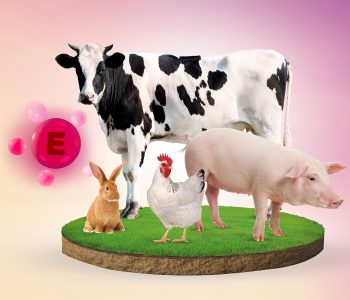Grape polyphenols (NuxaFen®) can replace synthetic vitamin E in standard and demanding dietary formulations.
INTRODUCTION
Polyphenols work as antioxidants by:
Previous studies have shown that NuxaFen® can partially replace synthetic vitamin E in broiler diets without altering zootechnical performance (Dewez et al., 2022).
OBJECTIVE
Evaluate the capacity of NuxaFen® to partially or totally, replace synthetic vitamin E in broilers fed a diet with high levels of polyunsaturated fatty acids, Fe and metabolizable energy (ME).
MATERIALS & METHODS
The study was conducted with the research service of ZOOTEST. Ploufragan and within a commercial barn (GAEC
de La Ville Gestin. Gestin 22640).
One thousand and twenty (1020) day-old ROSS-308 chicks (100% males) were weighed and randomly distributed among 60 pens (N=17 chicks / pen) and 6 treatments (T) (Table 1).
and in T 3 and 6, 100% of vitamin E was replaced by
4.6 mg/kg NuxaFen®.
| T4. T5 and T6 were higher in ME and contained 5% of linseed oil and 0.2% of FeS04 to increase the oxidative stress in the birds (challenged feeds). |
The trial had a duration of 42 days.
Table 1: Treatment Description.
1ME levels for starter diets (1-14 d), growth (15-28 d) and finisher (29-42 d), respectively.
RESULTS
Broilers fed the challenged feeds (Diet B. Figure 1) achieved a lower body weight (BW) at 42 days, nevertheless the only significant difference (p < .05) was observed between T 1 and 3 (higher BW) compared to T6 (lower BW).
Within the type of feed, no differences (p > .05) were observed between treatments.
of a reduction in feed intake (data not shown). |
Figure 1. Body weight at 42 days:
Diet A: standard diet; Diet B: high ME, with 5%linseed oil and 0.2% FeSO4
Other measurements recorded during the study, including antioxidant status of the birds and processing yields did not differ (p >.05) between feed type or treatments (data not shown).
Figure 2. Feed conversion rate at 42 days:
Diet A: standard diet; Diet B: high ME, with 5% linseed oil and 0.2% FeSO4.
Overall results show no difference in performance of broilers supplemented with synthetic vitamin E ar grape extract either with partial or full replacement.
CONCLUSIONS
| NuxaFen® can partially or totally replace synthetic vitamin E with a 1:11 ratio, without compromising zootechnical performance. |
REFERENCES
Dewez et al. (2022). Comparative effect of partial vitamin E replacement with dry grape seed extract (Vitis Vinifera spp. Vinifera) on broiler performance and antioxidant status under stress conditions. World Poultry Congress, Paris.
Content produced by Nuproxa Switzerland Ltd
You may also be interested in: “Natural and effective solutions for animal nutrition and welfare(Nuproxa).”
